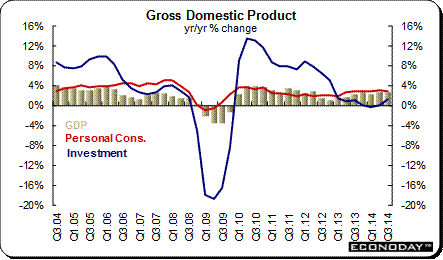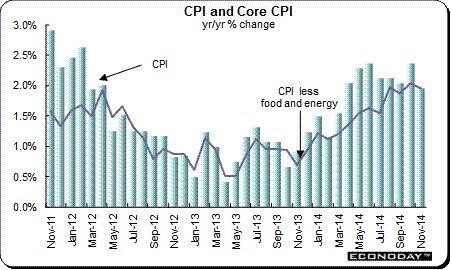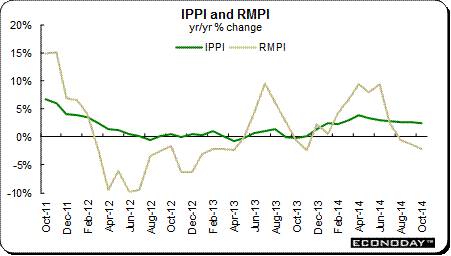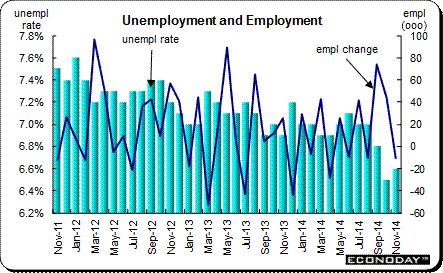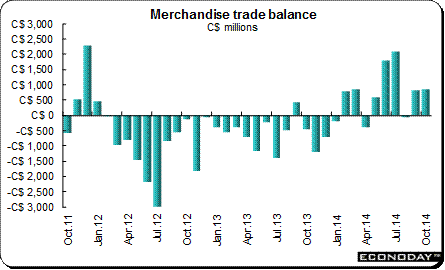
|
Gross Domestic Product The Canadian economy managed to grow without a recession for 15 years. But that changed as the worldwide recession drastically reduced its need for Canadian exports. On a geographic basis, the west, with its vast mineral resources has outperformed the manufacturing reliant east. Unlike the U.S., Canada releases GDP data only once a quarter, usually about two months after the reference quarter's end.
Growth slowed dramatically in 2008 as seen in the graph below. Although the fourth quarter of 2008 in reality was the first quarter in which the economy contracted, there was little doubt that the recessionless streak had ended. The economy contracted for three quarters before rebounding in the third quarter of 2009. Canada has continued to grow steadily since then.
Third quarter GDP was up 0.7 percent and 2.6 percent from the same quarter a year ago. This follows a second quarter gross domestic product reading of 0.9 percent. GDP was up at an annualized pace of 2.8 percent. The slowdown was mainly attributable to a deceleration in consumer spending which was up a quarterly 0.7 percent following a 1.1 percent increase in the second quarter. Elsewhere within domestic demand, government final consumption was flat after a 0.3 percent increase but gross fixed capital formation picked up from a 0.8 percent rate to 1.3 percent. Within the latter, residential investment expanded 3.0 percent. Inventories had a negative impact, reducing the quarterly change in total output by 0.2 percentage points. Final domestic demand matched the headline's 0.7 percent quarterly increase. A 1.7 percent quarterly increase in exports outpaced a 1.0 percent rise in imports to see net foreign trade add 0.2 percentage points to growth. The improvement here was also reflected in a narrowing in the current account deficit from C$9.9 billion in the second quarter to C$8.4 billion.
Monthly gross domestic product In addition to quarterly GDP data, Canada also releases monthly data for gross domestic product at basic prices. The data provide a monthly update on the economy's performance and a check on the quarterly GDP data.
Following a dismal contraction in December 2013, the real economy bounced back in January 2014. A 0.3 percent monthly increase in total output on the year nudged annual growth to 2.3 percent. The almost full recovery from December's 0.4 percent monthly slide reflected rebounds in both the goods producing and service sectors. February monthly GDP added 0.2 percent while March edged up 0.1 and April added 0.2 percent. This was the fourth consecutive month that real GDP grew since its weather induced contraction at the end of 2013 but it was still not enough to boost the annual growth rate which held steady at 2.0 percent.
June monthly GDP was up 0.3 percent, well short of May's upwardly revised 0.5 percent advance but still enough to lift annual growth to a healthy 3.2 percent. The monthly increase was biased towards the goods producing sector. In July, however monthly GDP weakened to virtually no growth and in August, it retreated 0.1 percent.
September's 0.4 percent advance was largely attributable to goods producing industries where output posted its first monthly increase since June. However, 1.0 percent gain failed to reverse the cumulative 1.3 percent drop in July/August. Manufacturing was up a solid 0.8 percent, utilities 1.7 percent and mining, quarrying, and oil & gas extraction 2.5 percent. Partial offsets were provided by agriculture, forestry, fishing & hunting (down 0.5 percent) and construction (down 0.2 percent). Services lagged with a modest 0.2 percent monthly advance within which wholesale (1.7 percent) and retail trade (0.7 percent) were easily the best performing sub-sectors. Finance & insurance (0.5 percent) also held up well. However, elsewhere output was mainly flat or down with the most notable monthly declines in educational services (1.0 percent) and arts, entertainment & recreation (0.6 percent).
Inflation There are several price indexes that can be used to sniff out inflationary trends if they exist. They are the consumer price index plus its two major core measures and the industrial product price and the raw material price indexes. The latter two measure producer inflation while the CPI measures inflation at the consumer level. Consumer inflation has remained under control and within the Bank of Canada's target range of 1 percent to 3 percent. In November, the CPI was down 0.4 percent but was up 2.0 percent from a year ago. Core CPI, excluding only food and energy, was down 0.3 percent and was up 1.9 percent on the year.
Producer prices have been volatile. However, after a period of rising prices, the increases moderated. It should be noted that producers for the most part are unable to pass along high raw material prices. Some of the raw material price changes were exacerbated by exchange rate volatility which in turn feeds back into these prices. Soaring and sinking commodity prices also played a role.
Unemployment — After climbing to a high of 8.7 percent in August 2009, the unemployment rate steadily declined to 7.1 percent. In 2013, the unemployment rate was in a narrow range of 7.2 percent for a high to 6.9 percent for a low. In November, the unemployment rate was 6.6 percent. In October, 43,100 new jobs were added. However, in November, 10,700 jobs were lost. In 2014, a total of 190,000 new jobs have been added.
Merchandise trade — Canada consistently runs a trade surplus with the U.S. and on occasion, Japan — but a deficit with all other trading partners. The trade surplus declined in 2006 primarily because of the relatively high value of the Canadian dollar against most other currencies, but especially against the U.S. dollar.
The Canadian merchandise trade balance recorded a deficit in December 2008 for the first time since March 1976. The trade balance since then has veered from positive to negative. The balance was in deficit for eight of 12 months in 2011 and for all of 2012. Canada managed a trade surplus in June 2013 and again in February and March 2014. However, it slipped into deficit again in April and again in May. The balance tipped into surplus in June and July. However, in August it once against slipped into deficit. In September and October, the balance was once again positive.
The trade balance in part, has been affected by the Canadian dollar's exchange rate. The higher value of the currency made Canadian exports more expensive while at the same time, making imports cheaper. The Canadian dollar steadily weakened against the U.S. currency for most of 2013, taking it below parity where it has remained in 2014. This should make Canadian exports more attractive in the U.S. and elsewhere and have a positive effect on the merchandise trade balance.
|
|||||||
| Legal Notices | ©Copyright 1998-2025 Econoday, Inc. |
powered by
![[Econoday]](images/logo.gif)
![[Apple App Store]](/images/AppleAppStore.png) ![[Econoday on Kindle]](/images/kindle.jpg) 
|
||||||
